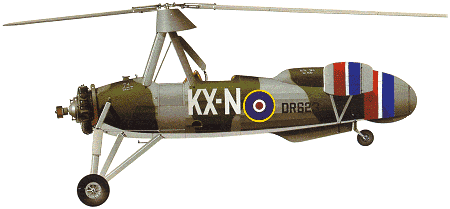
| Cierva C.30 1922 |  |
 |

| Cierva C.30 1922 |  |
 |
|
The Cierva C.30A marked a major step forward in rotorcraft development, being the first production autogiro in which the engine was geared directly to drive the rotor blades for take-off. The degree of direct control was increased still further by having the control column, which acted directly on the rotor, suspended from the pylon so that the rotor head could be tilted in any direction to produce the manoeuvre desired. The new-style control system was first installed in G-ABXP, a Cierva C.19 designated Mk.V with a 100hp Genet Major I engine. This was basically a C.19 Mk.IV modified to have a clutch and transmission shaft, a tilting rotor head and (later) a small, fixed tailplane. The prototype C.30 (G-ACFI) differed chiefly in having a tripod rotor pylon and dihedral on the tailplane tips; the fuselage was modified by Airwork from a standard Cierva C.19, and assembly was undertaken by National Flying Services at Hanworth, where G-ACFI made its maiden flight early in April 1933. Take-off run of the C.30 was about 30 yards (27.43m), while the landing was achieved in about 3 yards (2.74m) with the rotor blades autorotating. Another 1933 prototype was G-ACKA, the first C.30P, with 140hp Genet Major 1A, folding rotor blades and other improvements. First customer for the production C.30A was the Royal Air Force, for whom the type was built by Avro and given the name Rota. One twin-float Sea Rota and ten standard Rotas with wheeled undercarriages were completed to Specification 16/35, and were delivered to the School of Army Co-operation from December 1934. One other military C.30A was K4775, a Civet Major-engined machine sent to the Royal Aircraft Establishment in 1935 for blade-flexing tests. Avro production of C.30 types was in the region of seventy aircraft, three of which were C.30P's. Thirty-seven C.30A's appeared on the pre-war British civil register, and others were completed for customers in Europe, India, China, Australia and South Africa. In Britain the C.30A, like the C.19 before it, was used for traffic reporting duties at major sporting and similar events, and one aircraft (G-AGUT) was used for filming the 1936 F.A. Cup Final. During 1933 the C.30 prototype, G-ACFI, was converted for jump-start trials with a modified rotor head, and in 1936 a perfected form of this was fitted to G-ACWF when it made the first genuine vertical take-off by an autogiro, by keeping the engine and rotor system engaged throughout the take-off sequence. This machine was, in effect, the prototype for the C.40, five of which were ordered for the R.A.F. as the Rota II to Specification 2/36. These were built by the British Aircraft Manufacturing Co., having side-by-side seats, wooden semi-monocoque fuselages and 175hp Salmson 9NG engines. Two of the original five Rota II's were diverted to civilian customers, replacements being built in 1938-39. The R.A.F. C.40's served with No.1448 Flight (later 529 Squadron). On the outbreak of World War 2 over a dozen civil C.30A's were impressed for military service; these and the surviving Rota I's were allocated singly to R.A.F. radar stations in the United Kingdom for calibration duties. The example illustrated is the former G-ACWP, rebuilt in 1962 by R.A.F. apprentices at Halton and now in possession of the Science Museum, London. K.Munson "Helicopters And Other Rotorcraft Since 1907", 1968 
|